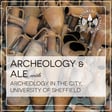
Dealing with the Devil: The Ritual Protection of Buildings Against Evil with James Wright - Ep 27
Archaeology and Ale is a monthly series of talks presented by Archaeology in the City, part of the University of Sheffield Archaeology Department’s outreach programme. In this talk, Archaeology in the City proudly presents - James Wright on *“Dealing with the Devil: The Ritual Protection of Buildings Against Evil”* This talk took place on Thursday, October 25th, 2019 at the Red Deer in Sheffield.
James Wright is an expert in recording and analysing historic standing buildings. He specialises in medieval and early modern buildings, vernacular architecture and the study of architectural fragments. In this episode, James teaches us about his work documenting ritual marks at historic structures and explains how these marks were used to protect against demons, devils, and other evildoers.
For more information about Archaeology in the City’s events and opportunities to get involved, please email archaeologyinthecity@sheffield.ac.uk or visit our website at archinthecity.wordpress.com. You can also find us on Twitter (@archinthecity), Instagram (@archaeointhecity), or Facebook (@archinthecity)
**Content Warning: Listener discretion is advised as there is adult language**
Affiliates